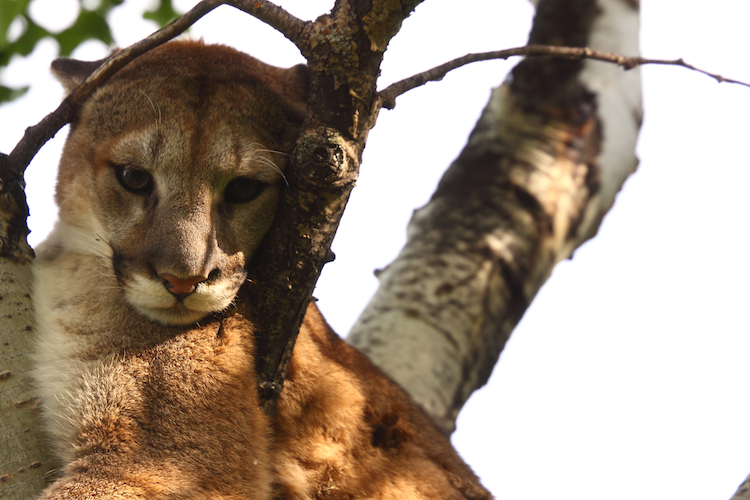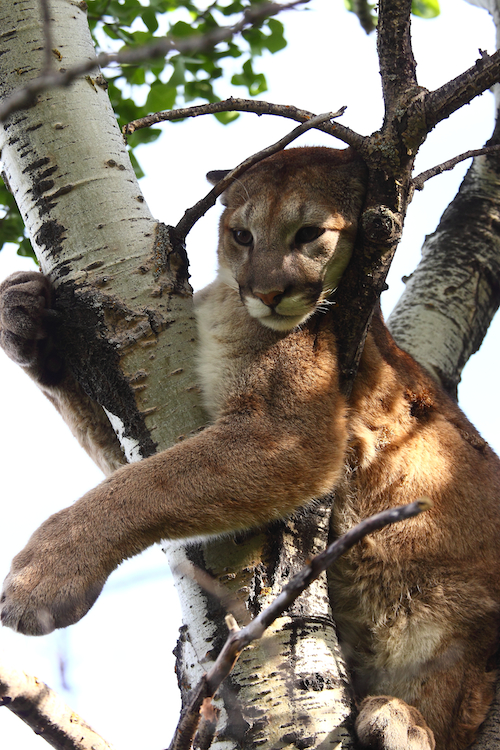
The common names catamount, cougar, mountain lion, panther, and puma all refer to the Puma concolor species.
FAMILY
Felidae, which includes both wild and domestic cats
RANGE
North America (Canada and the Western U.S., with small populations in Florida), Central America, and South America
Important Environmental Factors

Moderate variation in seasonal temperature

Low levels of paved or compacted ground

Greater than 250 millimeters per year
Habitat and Behavior
Mountain lions are large predators that typically weigh between 75-175 pounds [1]. Their diet mainly consists of ungulate species like mule deer, elk, and bighorn sheep, but they will also feed on smaller mammals, grass, and carrion depending on what is available and abundant. When feeding, adult mountain lions can eat 20-30 pounds of meat at a time. They then cache or bury the rest of the prey in a hidden spot that they may return to for up to 10 days after. Mountain lions can live in many habitat types, as long as there is sufficient prey and cover, e.g. rocky outcrops, boulders, or dense vegetation [2]. This cover is useful for hunting and stalking prey, as well as protecting kittens in their den sites. In California, typical mountain lion habitats include mountainous coniferous forests and brush-covered foothills, and they may also occupy swamps, grasslands, and lowland tropical forests elsewhere in their range.
Threats
Though mountain lions have the largest terrestrial distribution of any native mammal in the western hemisphere, humans have greatly reduced their range. In the U.S., bounty hunting of mountain lions continued into the 1960s [1], and several subspecies outside of California are endangered [2]. The loss of mountain lions and other predators has resulted in larger herbivore populations, overgrazing, and thus erosion and ecosystem decline. Hunting of mountain lions is prohibited in California. However, they are still threatened by habitat loss, isolated populations and gene flow restriction due to habitat fragmentation, and increased conflicts with humans. One study found that, in Southern California, humans are the main cause of mountain lion deaths [3]. The majority are killed in vehicle collisions, but many are also hunted after they kill domestic animals, which allows owners to acquire depredation permits.
Wildlife Encounters
Mountain lions are usually wary of people and appear to actively avoid us. In fact, only 16 attacks on humans have occurred in California since 1890 [4]. In Los Angeles, mountain lions are primarily restricted to the Santa Monica and San Gabriel Mountains and sightings of these solitary predators are relatively rare. If you do encounter a mountain lion, remember these tips from the National Park Service:
- Do not turn and run! A mountain lion’s instinct is to give chase.
- Maintain eye contact, and do not turn your back on the mountain lion.
- Try to appear larger: stand up straight, and raise your arms above your head.
- Back away from the mountain lion, as it may be guarding a prey cache or den.
- If the mountain lion approaches, yell and throw rocks or sticks.
- If the mountain lion attacks, fight back. Do not play dead, as you might with a bear.

Data source:
Species records provided by iNaturalist
References:
- National Park Service. Mountain Lion. Updated February 24, 2015. [link]
- Tesky (1995). Puma concolor. In: Fire Effects Information System, [Online]. U.S. Department of Agriculture, Forest Service, Rocky Mountain Research Station, Fire Sciences Laboratory (Producer). [link]
- Vickers et al. (2015) in PLoS One 10(7) [link]
- California Department of Fish and Wildlife. Mountain Lions in California. [link]